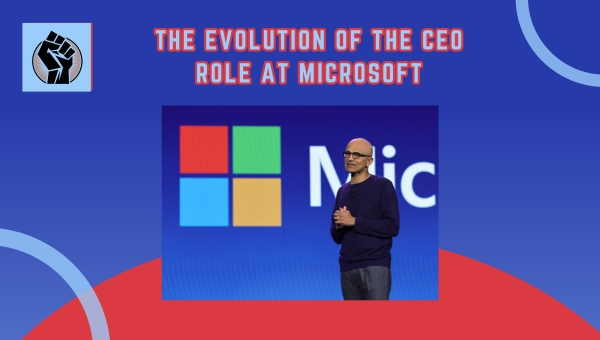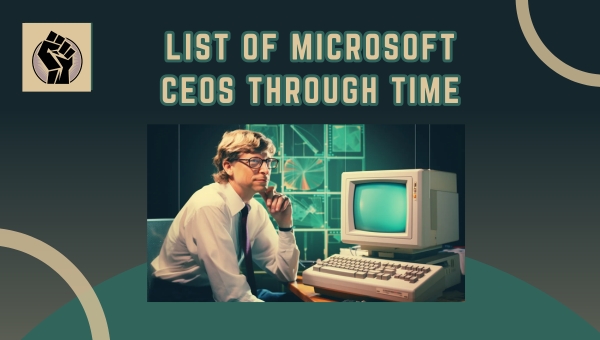In the vibrant world of technology, the role of the CEO at Microsoft has transformed remarkably. Imagine a time when Microsoft was struggling to keep up with rapid technological advancements. Then, a new leader emerged, steering the ship with fresh ideas and a renewed sense of purpose.
These leaders, equipped with a visionary approach, has not only navigated the company through turbulent waters but also propelled it to new heights. The journey to understanding the CEO at Microsoft’s impact on the company’s growth, innovation, and future is both compelling and insightful. Join us as we delve into this transformative leadership and its profound influence on Microsoft’s trajectory.
The Evolution of the CEO Role at Microsoft
The role of the CEO at Microsoft has transformed dramatically since the company’s founding in 1975. As the technology landscape has evolved, so too has the leadership approach required to navigate its complexities.

This evolution reflects shifts in market demands, corporate culture, and technological advancements, showcasing how Microsoft’s CEOs have adapted to ensure the company’s continued success.
Here are the key phases in this evolution:
- Founding Era: Bill Gates and Paul Allen established Microsoft in 1975, focusing on software for personal computers, with Gates as the driving visionary.
- Growth and Expansion: Steve Ballmer became CEO in 2000, steering the company through rapid growth and market dominance, emphasizing aggressive sales strategies and product diversification.
- Cultural Shift: Satya Nadella took over in 2014, initiating a cultural transformation towards collaboration, innovation, and cloud computing, significantly enhancing Microsoft’s market position.
- Focus on AI and Cloud: Under Nadella, Microsoft pivoted towards artificial intelligence and cloud services, positioning itself as a leader in these critical areas.
- Diversity and Inclusion: Nadella emphasized the importance of diversity and inclusion within the workforce, fostering a culture that values different perspectives.
Today, the CEO role at Microsoft encompasses strategic vision, technological innovation, and a commitment to corporate responsibility in a rapidly evolving global landscape.
Also Read: History of Chief Executive Officers of Google
List Of Microsoft CEOs Through Time
Microsoft has been shaped by visionary leaders who have left an indelible mark on the technology industry. From its inception to the present day, the company has witnessed a dynamic evolution under the leadership of its CEOs.

Let’s take a closer look at the pivotal roles played by these individuals and how they steered Microsoft through various phases of innovation and growth.
1. Bill Gates (1975-2000)
Bill Gates co-founded Microsoft in 1975 with Paul Allen, setting the stage for a revolution in personal computing. Gates was not only a visionary but also a driving force behind Microsoft’s initial success. Under his leadership, Microsoft introduced groundbreaking products that changed the way people interacted with technology.
One of the most notable achievements was the development of the Windows operating system, which became a staple in households and businesses worldwide. Gates’ focus on software development and innovation helped Microsoft dominate the PC market, making it a household name.
He was instrumental in establishing the company’s competitive edge by emphasizing the importance of software over hardware. His leadership style was characterized by a relentless pursuit of excellence and innovation, which laid the foundation for Microsoft’s future growth and success.
2. Steve Ballmer (2000-2014)
Steve Ballmer took the reins in 2000, steering Microsoft through a period of significant transformation. His tenure was marked by a strong emphasis on enterprise solutions and global expansion. Ballmer recognized the potential of the corporate market and shifted Microsoft’s focus towards enterprise software, leading to the development of products like Windows Server and Microsoft Office.
Under his leadership, Microsoft expanded its presence in international markets, strengthening its global footprint. Ballmer also oversaw the acquisition of companies like Skype and Nokia, aiming to diversify Microsoft’s product portfolio.
Despite facing challenges from competitors like Apple and Google, Ballmer’s strategic decisions ensured Microsoft’s continued relevance in the tech industry. His leadership style was characterized by enthusiasm and a commitment to maintaining Microsoft’s market dominance.
3. Satya Nadella (2014-present)
Satya Nadella’s tenure as CEO has been a period of remarkable growth and innovation for Microsoft. Since taking over in 2014, Nadella has focused on transforming Microsoft into a leader in cloud computing.
He spearheaded the development and expansion of Microsoft Azure, positioning it as a major player in the cloud services market. Nadella’s vision extended beyond technology; he emphasized a culture of collaboration and inclusivity within the company.
Under his leadership, Microsoft embraced open-source initiatives and formed strategic partnerships with competitors, fostering a more cooperative environment. Key achievements under Nadella’s leadership include:
- Doubling Microsoft’s stock value and market capitalization.
- Expanding the reach of the Office 365 suite and improving its integration with cloud services.
- Enhancing Microsoft’s AI capabilities through initiatives like Cortana and Azure AI.
Nadella’s focus on innovation and adaptability has ensured Microsoft’s continued relevance in a rapidly evolving tech landscape.
Impact on Microsoft’s Growth
Microsoft’s growth has been significantly shaped by the strategic leadership of its CEOs, particularly under Satya Nadella. His tenure, beginning in 2014, marked a pivotal shift towards cloud computing and artificial intelligence, which has driven substantial financial performance.
Key impacts include:
- Revenue Growth: Microsoft’s annual revenue soared from $86 billion in 2014 to over $230 billion in 2023, primarily due to the success of Azure and Office 365.
- Market Capitalization: The company’s market cap increased dramatically, surpassing $2 trillion in 2021, reflecting investor confidence in its strategic direction.
- Innovation Focus: Nadella’s emphasis on innovation led to significant investments in AI and cloud technologies, enhancing product offerings and customer engagement.
This growth trajectory highlights how effective leadership and a clear vision can transform a company’s fortunes. As Microsoft continues to adapt to technological advancements and market demands, its commitment to innovation remains crucial for sustained success.
Challenges Faced by CEOs
Chief Executive Officers (CEOs) face a myriad of challenges in today’s dynamic business environment. These challenges can significantly impact their organizations and require strategic thinking and effective leadership.
Below is a detailed overview of the primary challenges faced by CEOs.
- Economic Uncertainty:
- CEOs must navigate unpredictable market conditions and increased competition from globalization, which can impact consumer spending and profitability.
- Technological Advancements:
- Keeping up with rapid technological changes is crucial, including investing in digital transformation and addressing rising cybersecurity threats.
- Talent Management:
- Attracting and retaining skilled employees is a major challenge, alongside fostering employee engagement and maintaining a positive workplace culture.
- Regulatory Compliance:
- Ensuring compliance with complex and ever-changing regulations, including environmental standards, is essential for operational success.
- Crisis Management and Stakeholder Expectations:
- CEOs must effectively handle crises, protect the company’s reputation, and balance shareholder pressure with the demand for corporate social responsibility (CSR).
Also Read: Nvidia Founder | The Genius Transforming nvidia’s Future
Future Outlook for Microsoft Under Current Leadership
Microsoft’s future under the current CEO looks promising with strategic initiatives aimed at driving innovation and growth.

The focus will likely remain on several key areas:
- Cloud Computing Expansion: With a strong emphasis on cloud services like Azure, the company is expected to continue its growth trajectory, providing scalable solutions to businesses worldwide.
- Artificial Intelligence (AI) Integration: Microsoft is poised to integrate AI across its product lines, enhancing user experience and operational efficiency in various sectors.
- Sustainability Goals: Committed to sustainability, the company is working towards achieving its carbon-negative target by 2030, which will likely influence its operational strategies and investments.
- Enhanced Security Measures: As cyber threats evolve, Microsoft’s focus on cybersecurity will be crucial in protecting user data and maintaining trust.
- Diversity and Inclusion: Strengthening its culture, Microsoft aims to foster a more inclusive workplace, leveraging diverse talents to drive innovation.
These strategies highlight the company’s commitment to staying at the forefront of technological advancements while addressing global challenges. With this approach, Microsoft aims to maintain its leadership position in the tech industry.
FAQs
Who is the CEO of Microsoft Company?
The CEO of Microsoft is Satya Nadella. He took over the role in February 2014, and has since been steering the company towards cloud computing and other innovative technologies.
When was Microsoft Corporation Founded?
Microsoft Corporation was founded on April 4, 1975. It started as a small technology company and has grown to become a global leader in software and services.
Who are the Co-Founders of Microsoft?
Microsoft was co-founded by Bill Gates and Paul Allen. They started the company with the vision of bringing personal computing to the masses.
Conclusion
Satya Nadella’s role as CEO at Microsoft has been transformative. His leadership has steered the company through significant growth and innovation. By focusing on cloud computing and AI, Nadella has positioned Microsoft as a leader in technology. His management style emphasizes empathy and collaboration, fostering a positive organizational culture.
However, challenges like fierce competition and evolving market trends persist. Moving forward, Microsoft is poised to continue its trajectory of success under Nadella’s guidance, with ongoing investments in cutting-edge technologies.
If you found this insightful, explore more on our site for additional blogs covering leadership and innovation in the tech industry.





